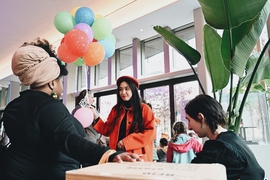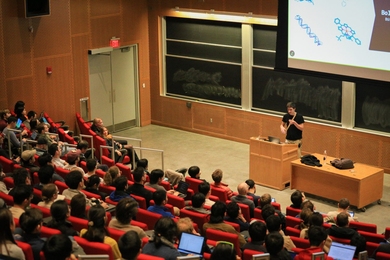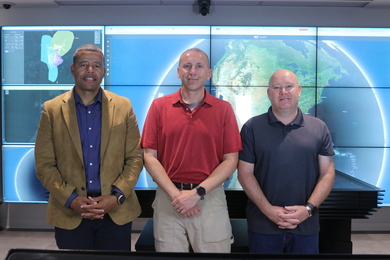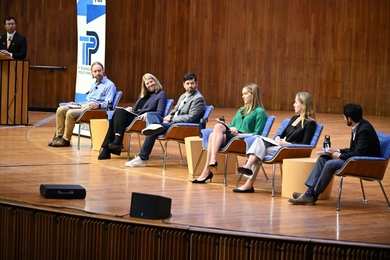The newly established Morningside Academy of Design (MAD) Professorships recognize outstanding faculty whose teaching, research, and service have significantly shaped the field of design at MIT and beyond. The appointments support a commitment to interdisciplinary collaboration, mentorship, and the development of new educational approaches to design.
These appointments mark the creation of the MAD Professorships and were formally announced on April 29 at the MAD in Dialogue event, where faculty members, introduced by their department heads, each gave a short presentation on their work, followed by a shared conversation on the future of design education.
The inaugural chair-holders are Behnaz Farahi, assistant professor of media arts and sciences and director of the Critical Matter Group in the MIT Media Lab; Skylar Tibbits, associate professor of architecture, co-founder and director of the MIT Self-Assembly Lab, and assistant director for education at MAD; and David Wallace, professor of mechanical engineering, MacVicar Fellow, and Class of 1960 Innovation in Education Fellow.
John Ochsendorf, MAD’s founding director, reflects that “the professorships are more than titles — they’re affirming the central role of design in empowering students to solve complex challenges. Behnaz, Skylar, and David are all celebrated designers who each bring a unique perspective to design education and research. By supporting them, we will cultivate more agile, creative thinkers across MIT.”
Professor Farahi’s MAD professorship appointment will begin Sept. 1, upon the completion of her Asahi Broadcast Corp. professorship. Tibbits’ and Wallace’s appointments are effective immediately. The faculty members will remain affiliated with their respective departments.
Behnaz Farahi
Having joined the MIT faculty in fall 2024 as an assistant professor in media arts and sciences, Behnaz Farahi brings her critical lens to design research and education. With a foundation in architecture, her career spans fashion and creative technology. Farahi takes interest in addressing critical social issues with a design practice engaging emerging technologies, human bodies, and the environment. As director of the Critical Matter research group at the MIT Media Lab, Farahi aims to re-integrate the tradition of critical thinking in philosophy and social sciences with the concerns of “matter” in science and technology.
She has won awards including the Cooper Hewitt Smithsonian Design Museum Digital Design Award, Innovation by Design Fast Company Award, and the World Technology Award. Her work has been included in the permanent collection of the Museum of Science and Industry in Chicago and has been exhibited internationally.
Her most recent installation, “Gaze to the Stars,” projected video closeups of MIT community members’ eyes onto the Great Dome, with encoded personal stories of perseverance and transformation. The project integrated large language model and computer vision tools in service of a collective art experience.
Currently the recipient of the Asahi Broadcasting Corporation Career Development Professorship in Media Arts and Sciences, Farahi’s MAD appointment will begin after the completion of her present chair. She will remain affiliated with the MIT Media Lab.
Skylar Tibbits
An architect by training, Skylar Tibbits combines design and computer science as co-founder and director of the Self-Assembly Lab at MIT and associate professor of design research in the Department of Architecture. Dedicated to broadening the reach of design education, he directs the undergraduate design programs at MIT and contributes to its curricula.
At the Self-Assembly Lab, Tibbits oversees the advancement of self-assembly and programmable material technologies such as 4D knitting and liquid metal printing, with a plurality of applications ranging from garments and housing to coastal resilience.
He has designed and built large-scale installations and exhibited in galleries around the world, including the Museum of Modern Art, Centre Pompidou, Philadelphia Museum of Art, Cooper Hewitt Smithsonian Design Museum, Victoria and Albert Museum, and various others.
David Robert Wallace
David Wallace has long been a recognized leader in design research and education at MIT and around the world. Wallace began his research career focused on computational tools for design representation and has evolved his interests over time to environmentally-conscious design approaches, developing software tools to enhance design and creativity, and incorporating new media and tools into the design classroom to empower engineers and designers. His research goals are to develop new methods that impact upon the practice of product development and to help inspire and equip the next generation of engineering innovators.
Wallace is known both inside and outside of MIT for his development of two iconic design classes at MIT, 2.009 (Product Engineering Processes), and 2.00B (Toy Product Design). In sculpting and refining 2.009 over many years, Wallace merged a studio-based approach with rigorous engineering to create a new paradigm for team-based, project-based design. In these courses, students experience hands-on building and testing in real-world contexts so they experience what it means to design for real users, not just design in theory.
His approach to design education is captured in the video series “Play Seriously!,” which follows one semester of 2.009. For his tremendous educational contributions, he has been awarded the Baker Award for Teaching Excellence and was named a MacVicar Faculty Fellow, which is MIT’s highest teaching award.









